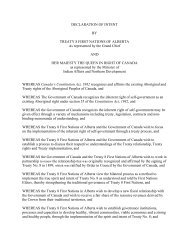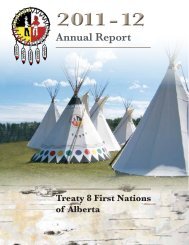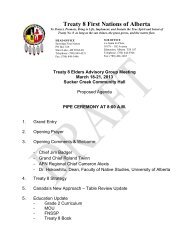Get the 2012-2013 report - Treaty 8 First Nations of Alberta
Get the 2012-2013 report - Treaty 8 First Nations of Alberta
Get the 2012-2013 report - Treaty 8 First Nations of Alberta
Create successful ePaper yourself
Turn your PDF publications into a flip-book with our unique Google optimized e-Paper software.
2007<br />
* 800+ Land Claims<br />
* Declaration on <strong>the</strong> Rights <strong>of</strong> Indigenous<br />
Peoples - The Canadian Government voted<br />
against it<br />
2008<br />
Prime Minister Stephen Harper’s historic<br />
apology for <strong>the</strong> Indian residential school<br />
system - June 11, 2008<br />
Sept 13, 2007 UN Declaration <strong>of</strong> <strong>the</strong> Rights <strong>of</strong> Indigenous People<br />
Canada and <strong>the</strong> <strong>First</strong> <strong>Nations</strong> Historical Timeline<br />
Health Co-Management Liaison<br />
The <strong>Alberta</strong> <strong>First</strong> <strong>Nations</strong>/FNIHB Regional Health Co-Management Committee was structured to jointly access,<br />
analyze, plan, and manage <strong>the</strong> administration <strong>of</strong> <strong>the</strong> <strong>Alberta</strong> Region Envelope. A formal agreement to co-manage<br />
<strong>the</strong> regional envelope was signed on November 18, 1996 by <strong>Alberta</strong> Chiefs and <strong>the</strong> Minister <strong>of</strong> Health.<br />
The essence <strong>of</strong> co-management in health services is based upon a viable partnership between <strong>First</strong> Nation<br />
community representatives and <strong>the</strong> <strong>First</strong> <strong>Nations</strong> and Inuit Health Branch (FNIHB). The goal <strong>of</strong> this partnership<br />
is to develop strategies leading to community health programs <strong>of</strong> direct client benefit. At times, <strong>the</strong>se strategies<br />
have focused on building infrastructure, while at o<strong>the</strong>r times; <strong>the</strong> focus has been on <strong>the</strong> development <strong>of</strong> health<br />
programs.<br />
Co-Management Priorities 2010 - 2015<br />
1. Increase collaboration between partners<br />
2. Positively change health outcomes<br />
3. Improve collection, access and use <strong>of</strong> health data<br />
4. Achieve strategic outcomes;<br />
a. Improved Immunization rates<br />
b. Reduced rates <strong>of</strong> teenage pregnancies<br />
c. Increased age <strong>of</strong> initiation to alcohol<br />
d. Accredited Health Director training<br />
e. Prevention <strong>of</strong> Child Abuse<br />
f. Reduced incidence <strong>of</strong> gang-related activities and incidence <strong>of</strong> family violence<br />
5. Recommitment to Co-Management principles<br />
The following Co-Management subcommittees have two representatives from each <strong>Treaty</strong> area and two FNIHB<br />
members. Each subcommittee shares decision making responsibility over specific programs:<br />
Non-Insured Health Benefits: Dental, Drugs/Medical Equipment, Transportation, and Vision & IRS<br />
Working Groups: Communications Strategy and Denial Tracking<br />
Child and Youth: Aboriginal Head Start on Reserve, Canada Prenatal Nutrition Program, Fetal Alcoholism<br />
Spectrum Disorder, Children’s Oral Health Initiative and Maternal Child Health<br />
Working group: Jordan’s Principle<br />
Mental Health & Addictions: Brighter Futures, Building Healthy Communities, National Native Alcohol and Drug<br />
Abuse Program (NNADAP), Suicide Prevention, Youth Solvent Abuse Program, National anti-drug Strategy &<br />
Canada Drug Strategy<br />
Working Groups: Drug Abuse Prevention Program (DUPP)<br />
Prevention: Aboriginal Diabetes Initiative, Chronic Diseases, Home & Community Care, Nursing, Community<br />
Health Representatives, Injury Prevention, Food Security Strategy<br />
Working Group: Injury Prevention, Food Security Strategy, Community Health Representative<br />
Health Protection: Communicable Disease Control, Blood Borne Pathogens and Sexually Transmitted<br />
Infections, Tuberculosis (TB) Control, Environmental Health<br />
Working Group: Health, Opportunity, Prevention & Education (HOPE)<br />
Page 31















